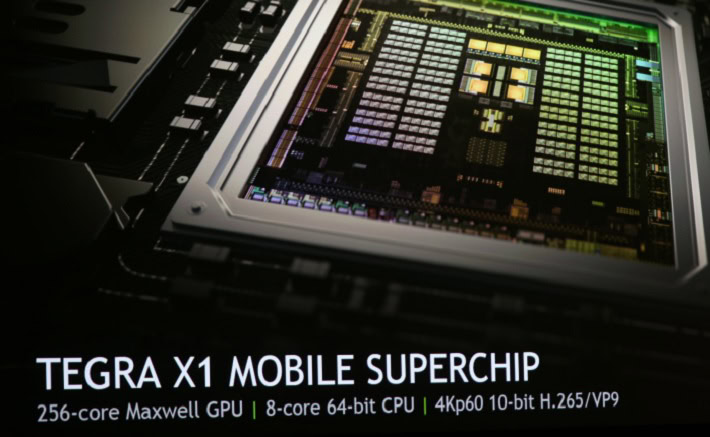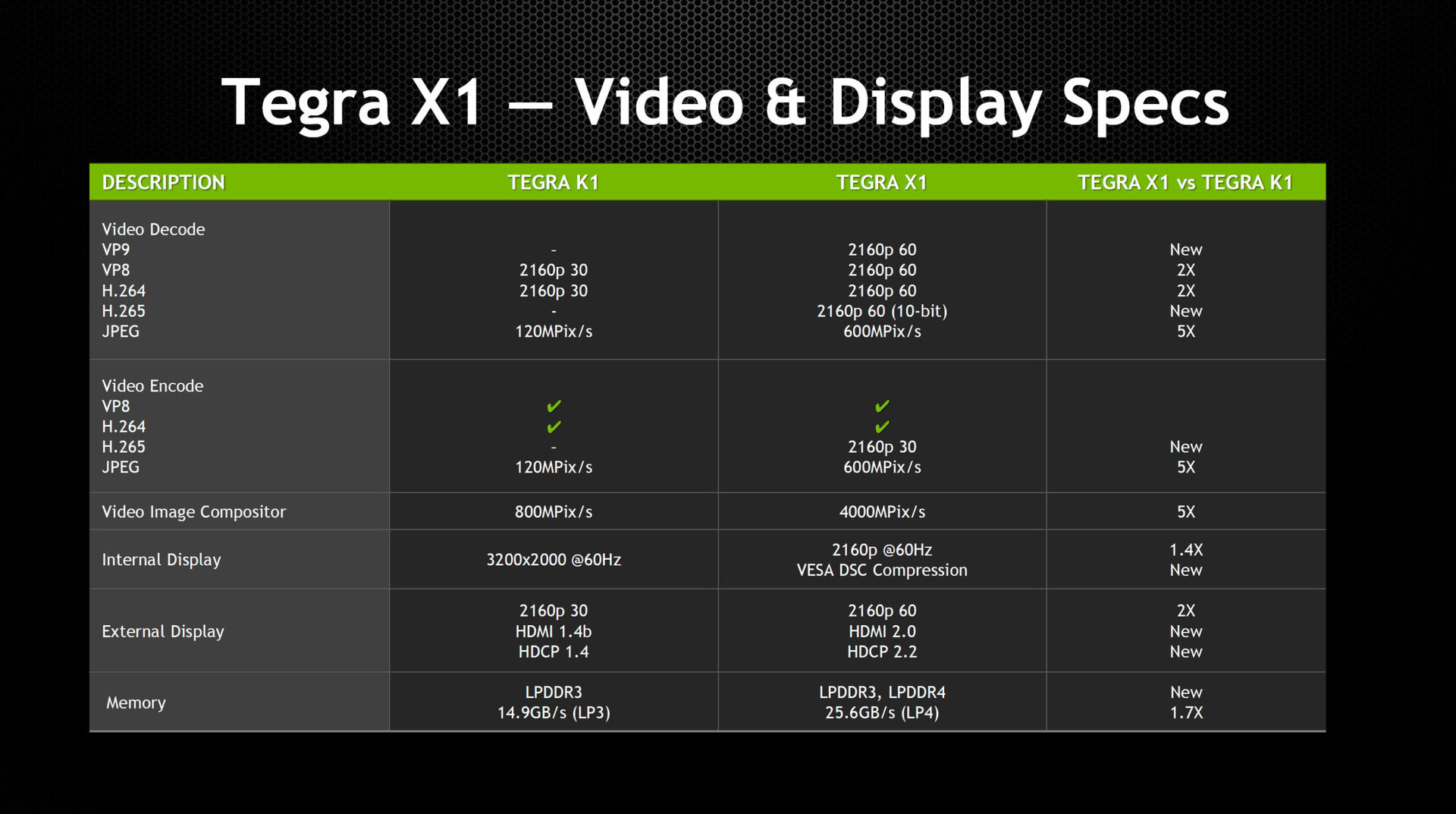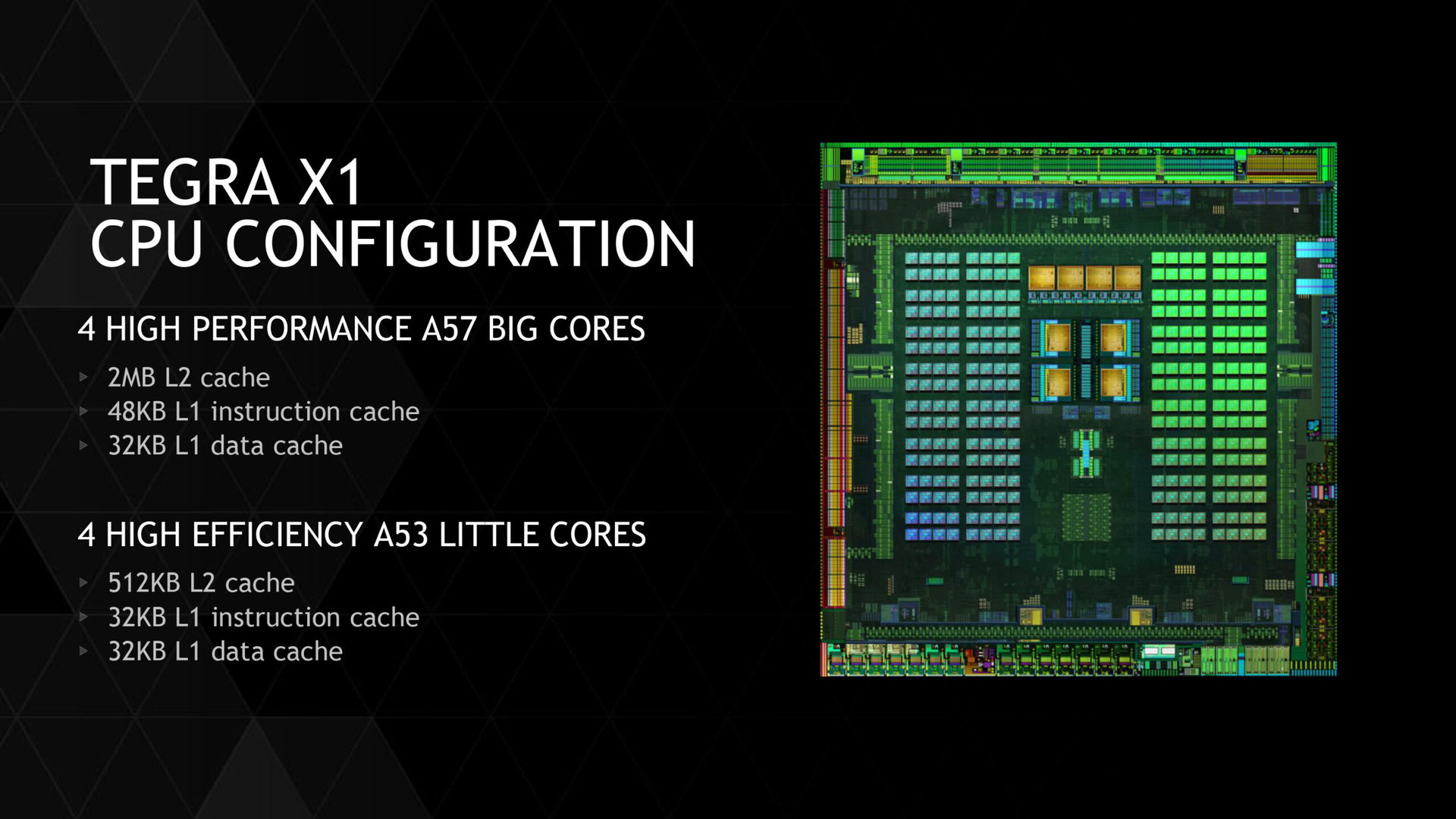Affiliate links on Android Authority may earn us a commission. Learn more.
NVIDIA announces latest mobile processor, the Tegra X1

At CES 2015 NVIDIA unveiled its next gen mobile CPU, the Tegra X1. The latest chip is based on NVIDIA’s 256-core Maxwell GPU, and features an eight-core 64-bit CPU and follows up last year’s Tegra K1.
The Tegra X1 is the first mobile processor to achieve 1 teraflop throughput, handles 4K video at 60Hz, and is said to be twice as powerful as the K1. It’s worth mentioning that the first supercomputer to pull off more than 1 teraflop did so in 2000 and needed 10 million watts to achieve such a feat, showing how far we’ve come. In addition to featuring a major boost in processing power, the X1 is also just as, if not slightly more, power efficient than its predecessor.
As per NVIDIA PR, here are the main specs of the new chip:
- 256-core Maxwell GPU
- 8 CPU cores (4x ARM Cortex A57 + 4x ARM Cortex A53)
- 60 fps 4K video (H.265, H.264, VP9)
- 1.3 gigapixel of camera throughput
- 20nm process

NVIDIA naturally focused on the graphics abilities of its so called “superchip” and highlighted the support for graphics standards like Unreal Engine 4, DirectX 12, OpenGL 4.5, CUDA(R), OpenGL ES 3.1 and the Android Extension Pack, as well as individual features like Voxel Global Illumination for real-time dynamic global illumination and Multi-Frame Anti-Aliasing.
“To achieve this dream, enormous advances in visual and parallel computing are required. The Tegra X1 mobile super chip, with its one teraflops of processing power, is a giant step into this revolution,” said NVIDIA’s CEO Jen-Hsun Huang.
On the CPU side, NVIDIA opted for a standard ARM configuration, with 4 fast Cortex A57 cores and 4 power saving Cortex A53 cores connected into a big.LITTLE configuration that allows on the fly allocation of resources depending on the task. This setup is similar to that used by Qualcomm on the Snapdragon 810, and it will be interesting to see how the chips fare against each others in benchmarks and real world performance. NVIDIA has skipped its custom Denver cores for the Tegra X1, though Denver may make a return on a future gen.

NVIDIA is also pushing hard automotive applications; a dual-Tegra X1 setup powers the Drive CX virtual cockpit/infotainment system, which is capable of handling 17MP of graphic output, the equivalent of two 4K screens.
At least at the time of this writing NVIDIA has yet to announce any devices that feature the Tegra X1, though the company offered a vague timeline for the rollout, with the first devices equipped with the chip to begin arriving in the first half of the year. NVIDIA has a history of having trouble delivering on its promises, so it remains to be seen whether Tegra X1 will fare any better.
Read the press release for the official rundown on Tegra X1.
[press]
Tegra X1 is built on the same NVIDIA Maxwell(TM) GPU architecture rolled out only months ago for the world’s top-performing gaming graphics card, the GeForce(R) GTX 980. The 256-core Tegra X1 provides twice the performance of its predecessor, the Tegra K1, which is based on the previous-generation Kepler(TM) architecture and debuted at last year’s Consumer Electronics Show.
Tegra processors are built for embedded products, mobile devices, autonomous machines and automotive applications. Tegra X1 will begin appearing in the first half of the year.
It will be featured in the newly announced NVIDIA DRIVE(TM) car computers. DRIVE PX is an auto-pilot computing platform that can process video from up to 12 onboard cameras to run capabilities providing Surround-Vision, for a seamless 360-degree view around the car, and Auto-Valet, for true self-parking. DRIVE CX is a complete cockpit platform designed to power the advanced graphics required across the increasing number of screens used for digital clusters, infotainment, head-up displays, virtual mirrors and rear-seat entertainment.
“We see a future of autonomous cars, robots and drones that see and learn, with seeming intelligence that is hard to imagine,” said Jen-Hsun Huang, CEO and co-founder, NVIDIA. “They will make possible safer driving, more secure cities and great conveniences for all of us.
“To achieve this dream, enormous advances in visual and parallel computing are required. The Tegra X1 mobile super chip, with its one teraflops of processing power, is a giant step into this revolution.”
Driven by the exceptional graphics compute horsepower from Maxwell, NVIDIA’s 10th-generation GPU architecture, Tegra X1 is the first mobile processor with capabilities that rival supercomputers and game consoles.
Faster Than Previous Top Supercomputer Indeed, Tegra X1 has more horsepower than the fastest supercomputer of 15 years ago, ASCI Red, which was the world’s first teraflops system. Operated for a decade by the U.S. Department of Energy’s Sandia National Laboratory, ASCI Red occupied 1,600 square feet and consumed 500,000 watts of power — with another 500,000 watts needed to cool the room it occupied. By comparison, Tegra X1 is the size of a thumbnail and draws under 10 watts of power.
As serious gamers know from using the NVIDIA(R) GeForce(R) GTX 980 GPU, the Maxwell architecture solves some of the most complex lighting and graphics challenges in visual computing. Its innovations include Voxel Global Illumination, or VXGI, for real-time dynamic global illumination and Multi-Frame Anti-Aliasing, or MFAA, for incredibly lifelike graphics in the most demanding games and apps.
“Tegra K1 set a new bar for GPU compute performance, and now just a year later Tegra X1 delivers twice that,” said Linley Gwennap, founder and principal analyst of the Linley Group. “This impressive technical achievement benefits both 3D graphics, particularly on devices with high-resolution screens, as well as GPGPU software that is becoming more prevalent, particularly in automotive applications.”
Technical Specifications Tegra X1 supports all major graphics standards, including Unreal Engine 4, DirectX 12, OpenGL 4.5, CUDA(R), OpenGL ES 3.1 and the Android Extension Pack, making it easier for developers to bring PC games to mobile.
Tegra X1’s technical specifications include:
-- 256-core Maxwell GPU
-- 8 CPU cores (4x ARM Cortex A57 + 4x ARM Cortex A53)
-- 60 fps 4K video (H.265, H.264, VP9)
-- 1.3 gigapixel of camera throughput
-- 20nm process
More details are available on the Tegra X1 website.[/press]